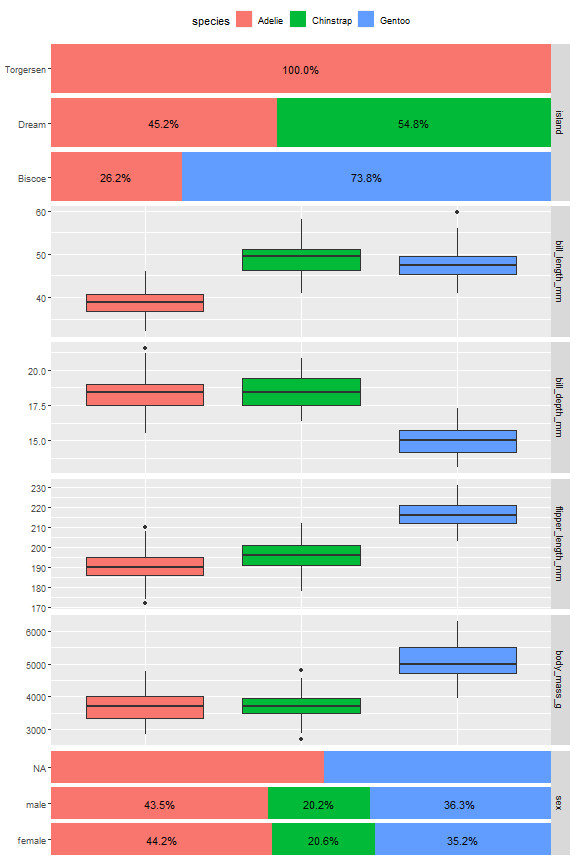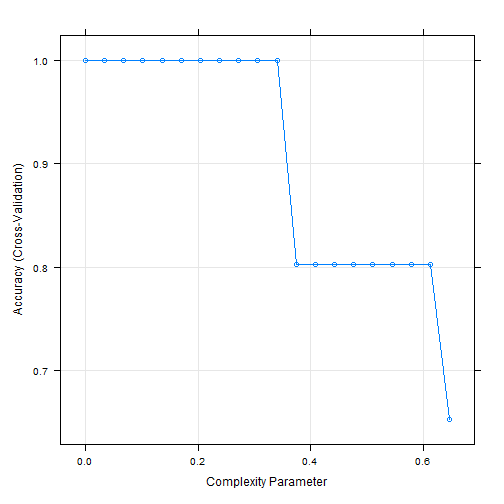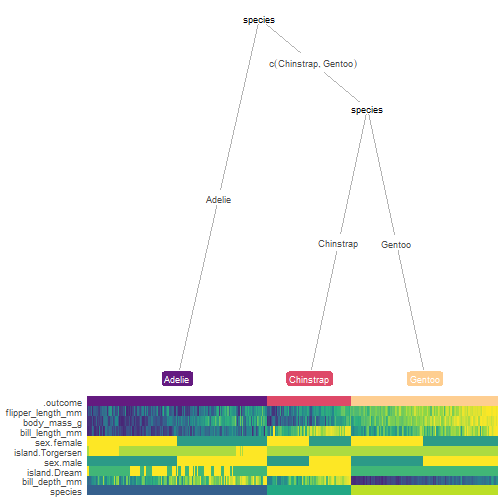前面已经铺垫了超多caret的基础知识,所以下面就是具体的实战演示了。
今天给大家演示下caret做决策树的例子,但其实并不是很好用,还不如之前介绍的直接使用rpart,或者tidymodels,mlr3。
加载数据和R包
library(caret)
library(modeldata)
str(penguins)
## tibble [344 × 7] (S3: tbl_df/tbl/data.frame)
## $ species : Factor w/ 3 levels "Adelie","Chinstrap",..: 1 1 1 1 1 1 1 1 1 1 ...
## $ island : Factor w/ 3 levels "Biscoe","Dream",..: 3 3 3 3 3 3 3 3 3 3 ...
## $ bill_length_mm : num [1:344] 39.1 39.5 40.3 NA 36.7 39.3 38.9 39.2 34.1 42 ...
## $ bill_depth_mm : num [1:344] 18.7 17.4 18 NA 19.3 20.6 17.8 19.6 18.1 20.2 ...
## $ flipper_length_mm: int [1:344] 181 186 195 NA 193 190 181 195 193 190 ...
## $ body_mass_g : int [1:344] 3750 3800 3250 NA 3450 3650 3625 4675 3475 4250 ...
## $ sex : Factor w/ 2 levels "female","male": 2 1 1 NA 1 2 1 2 NA NA ...
用这个企鹅数据集做演示。一共有377行,7列,其中species是结果变量,三分类,因子型,其余列是预测变量。
首先还是简单探索下数据:
library(GGally)
ggbivariate(penguins, "species")
## Warning: Removed 2 rows containing non-finite values (`stat_boxplot()`).
## Removed 2 rows containing non-finite values (`stat_boxplot()`).
## Removed 2 rows containing non-finite values (`stat_boxplot()`).
## Removed 2 rows containing non-finite values (`stat_boxplot()`).
## Warning: Removed 11 rows containing non-finite values (`stat_prop()`).

这个数据还可以,sex有一些缺失值,其他看着还行。
预处理
做个简单的预处理,连续性变量中心化,分类变量设置哑变量。预处理这部分不如tidymodels好用。
cent <- preProcess(penguins, method = c("center","scale"))
pen_df <- predict(cent, newdata = penguins)
class <- pen_df$species
dummy <- dummyVars(species ~. , data=pen_df)
pen_df <- predict(dummy, newdata = pen_df)
pen_df <- as.data.frame(pen_df)
pen_df$species <- class
str(pen_df)
## 'data.frame': 344 obs. of 10 variables:
## $ island.Biscoe : num 0 0 0 0 0 0 0 0 0 0 ...
## $ island.Dream : num 0 0 0 0 0 0 0 0 0 0 ...
## $ island.Torgersen : num 1 1 1 1 1 1 1 1 1 1 ...
## $ bill_length_mm : num -0.883 -0.81 -0.663 NA -1.323 ...
## $ bill_depth_mm : num 0.784 0.126 0.43 NA 1.088 ...
## $ flipper_length_mm: num -1.416 -1.061 -0.421 NA -0.563 ...
## $ body_mass_g : num -0.563 -0.501 -1.187 NA -0.937 ...
## $ sex.female : num 0 1 1 NA 1 0 1 0 NA NA ...
## $ sex.male : num 1 0 0 NA 0 1 0 1 NA NA ...
## $ species : Factor w/ 3 levels "Adelie","Chinstrap",..: 1 1 1 1 1 1 1 1 1 1 ...
建立模型
caret是可以调用rpart包实现决策树的,但是只支持一个超参数cp,感觉不如之前介绍的好用:
# 设定种子数
set.seed(3456)
# 根据结果变量的类别多少划分
trainIndex <- createDataPartition(pen_df$species, p = 0.7,
list = FALSE)
head(trainIndex)
## Resample1
## [1,] 2
## [2,] 7
## [3,] 8
## [4,] 9
## [5,] 10
## [6,] 12
penTrain <- pen_df[ trainIndex,]
penTest <- pen_df[-trainIndex,]
dim(penTrain)
## [1] 242 10
dim(penTest)
## [1] 102 10
# 选择重抽样方法,10折交叉验证
trControl <- trainControl(method = "cv", number = 10,
classProbs = T
)
set.seed(8)
tree_fit <- train(x = pen_df[,-1],
y = pen_df$species,
method = "rpart",
trControl = trControl,
tuneLength = 20
)
tree_fit
## CART
##
## 344 samples
## 9 predictor
## 3 classes: 'Adelie', 'Chinstrap', 'Gentoo'
##
## No pre-processing
## Resampling: Cross-Validated (10 fold)
## Summary of sample sizes: 310, 309, 310, 309, 310, 310, ...
## Resampling results across tuning parameters:
##
## cp Accuracy Kappa
## 0.00000000 1.0000000 1.0000000
## 0.03399123 1.0000000 1.0000000
## 0.06798246 1.0000000 1.0000000
## 0.10197368 1.0000000 1.0000000
## 0.13596491 1.0000000 1.0000000
## 0.16995614 1.0000000 1.0000000
## 0.20394737 1.0000000 1.0000000
## 0.23793860 1.0000000 1.0000000
## 0.27192982 1.0000000 1.0000000
## 0.30592105 1.0000000 1.0000000
## 0.33991228 1.0000000 1.0000000
## 0.37390351 0.8023203 0.6725971
## 0.40789474 0.8023203 0.6725971
## 0.44188596 0.8023203 0.6725971
## 0.47587719 0.8023203 0.6725971
## 0.50986842 0.8023203 0.6725971
## 0.54385965 0.8023203 0.6725971
## 0.57785088 0.8023203 0.6725971
## 0.61184211 0.8023203 0.6725971
## 0.64583333 0.6525957 0.3976620
##
## Accuracy was used to select the optimal model using the largest value.
## The final value used for the model was cp = 0.3399123.
plot(tree_fit)

library(rpart.plot)
## Loading required package: rpart
rpart.plot(tree_fit$finalModel)

library(treeheatr)
heat_tree(partykit::as.party(tree_fit$finalModel))

其他图形就不演示了,大家可以参考我们之前的推文。






















 3624
3624











 被折叠的 条评论
为什么被折叠?
被折叠的 条评论
为什么被折叠?








